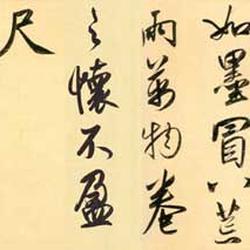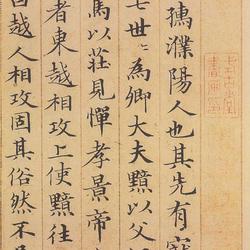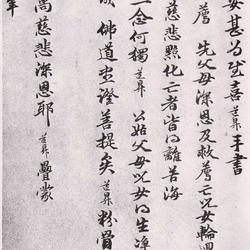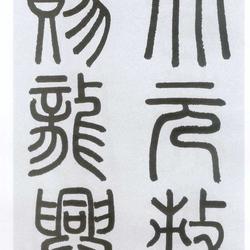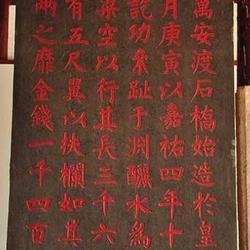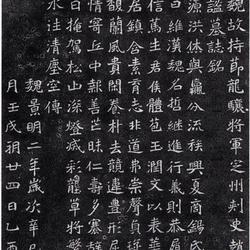
Mi Fu's "Yanshan Inscription" is a hand scroll on silk, running script, with a length of 36 cm and a width of 136 cm. It is written with thirty-nine large characters in running script on Chengxintang paper of the Southern Tang Dynasty. Collection of the Palace Museum, Beijing.
"Yanshan Inscription" is a representative work among Mi Fu's fine calligraphy works. This post is fast and majestic, full of ups and downs, and free and unrestrained in its knotting. It is not restricted by the rules of the predecessors and expresses the interests of nature. It is a rare treasure among Mi Fu's large-character works.
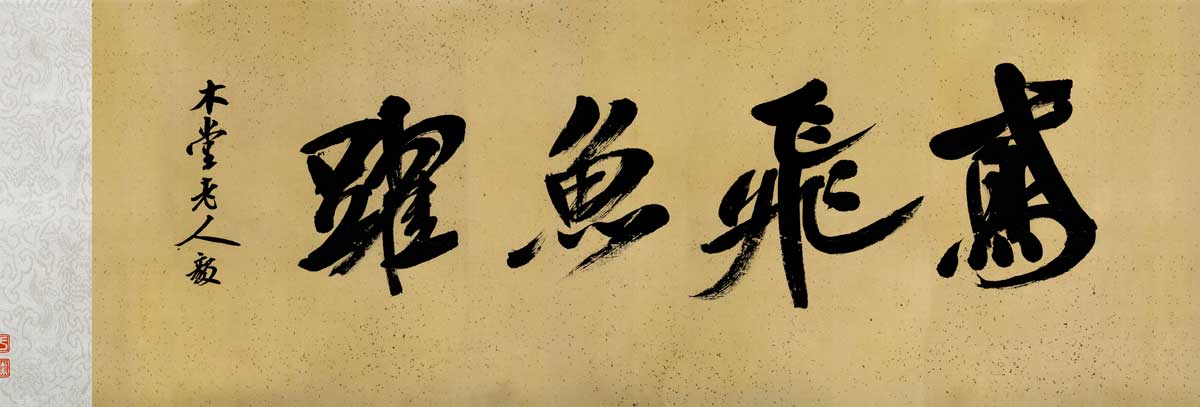

Explanation: Yanshan Ming. Five-color water, floating Kunlun. The pool is at the top, and black clouds appear. Hanging dragon monster, flashing electric marks. Xia Zhenting, Ze Houkun. Extreme changes, closed doors. Baojin Shanqianxuan Book.
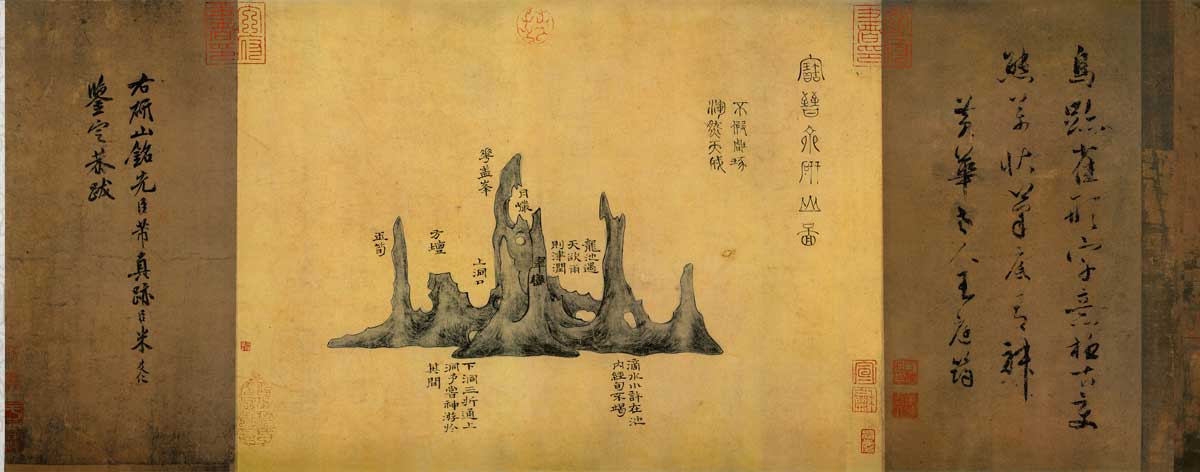
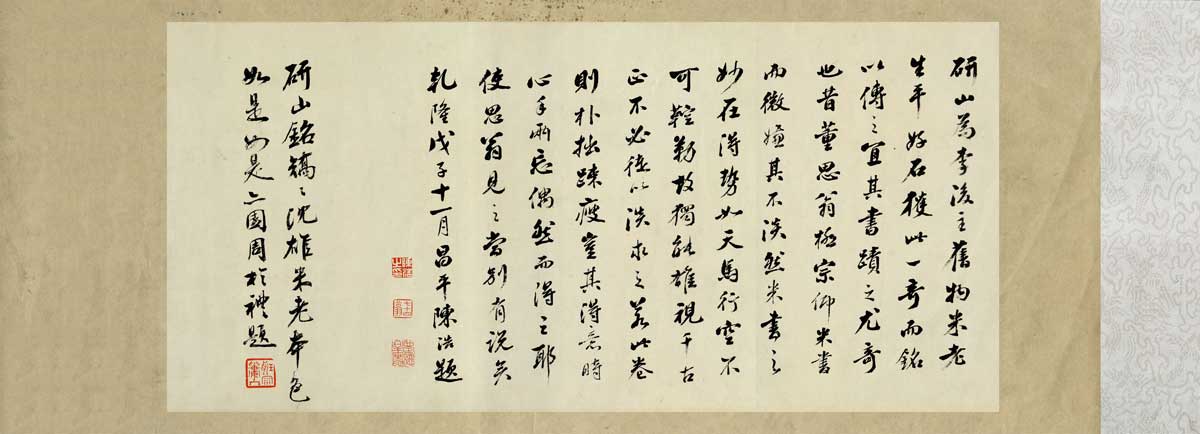
"Yanshan Inscription" is divided into three parts. The first part is thirty-nine characters written by Mi Fu on Chengxintang paper of the Southern Tang Dynasty: "Five-colored water floats on Kunlun. The pond is still, black clouds appear. There are dragon monsters hanging, and flashing spots. Extreme changes, closing the door. In front of Baojin Mountain Xuan Shu". The second part is a hand-drawn picture of mountain research, with a seal script that reads: "The picture of Baojin Zhai studying mountains is not artificially carved, it is completely natural." Yanshan is a mountain-shaped inkstone, and various parts of the Yanshan Strange Stone Map are marked in official script: "Huagai Peak", "Yueyan", "Fangtan", "Cuilan", "Jade Bamboo Shoots", "Shangdongkou", "Shangdongkou" The lower cave is connected to the upper cave by three folds. You can taste the spirit wandering in it. The third part is the running script inscription and postscript of Mi Fu's son Mi Youren: "You Yanshan Inscription, the original work of the late minister Mi Fu, and the authentic postscript of the minister Mi Youren." Mi Fu's nephew Wang Tingyun of the Jin Dynasty wrote a postscript: "The bird traces are in the shape of a sparrow, the meaning of the words is extremely ancient, and there are all kinds of abnormalities. There is a spirit in the bottom of the pen. Wang Tingyun, the old man of Huanghua." Chen Hao's postscript of the Qing Dynasty: "The inscription on Yanshan Mountain is an old thing of Empress Li. Mi Lao was fond of stones all his life. He found this strange thing and inscribed it to pass it on. It is fitting that his calligraphy is particularly strange. In the past, Dong Siweng Ji Zong admired Mi's calligraphy. But Wei Wei thinks it is not indifferent. The beauty of Mi Shu is that it is like a horse flying in the air, uncontrollable, so it can only be seen through the ages, and there is no need to seek it in vain. When you write this volume, you are simple and thin, how can you be proud of it? I forgot about it and got it by chance. If Si Weng saw it, I should not say anything about it. In the eleventh month of Wuzi period of Qianlong period, Chen Hao inscribed it in Changping. Zhou Yuli's postscript: "Study the inscription of the mountain, arrogant and subdued, the true character of Mi Lao, this is what it is. It is also the inscription of Zhou Yuli in the garden." The former Prime Minister of Japan, Takeshi Inukai, started the title with the words "The kite flies and the fish leaps, the old man in the wooden hall resolutely".
This hand scroll circulated orderly and entered the palaces of the Northern Song Dynasty and Southern Song Dynasty. During Lizong's reign in the Southern Song Dynasty, it was collected by Jia Sidao, the right prime minister. It was passed down to the Yuan Dynasty and was collected by Ke Jiusi, the most famous calligraphy and painting connoisseur in the Yuan Dynasty. During the Yongzheng period of the Qing Dynasty, it was collected by Yu Teng, a connoisseur of calligraphy and painting and the prefect of Chengdu, Sichuan. In modern times, it is surprising that he actually lives in Japan. The seals include: Neifu Shuyin (three times), Xuanhe, Shuanglong round seal, Jia Sidao, Yutang Ke's Jiu Si private seal and more than 20 seals.
The following is a partial enlargement
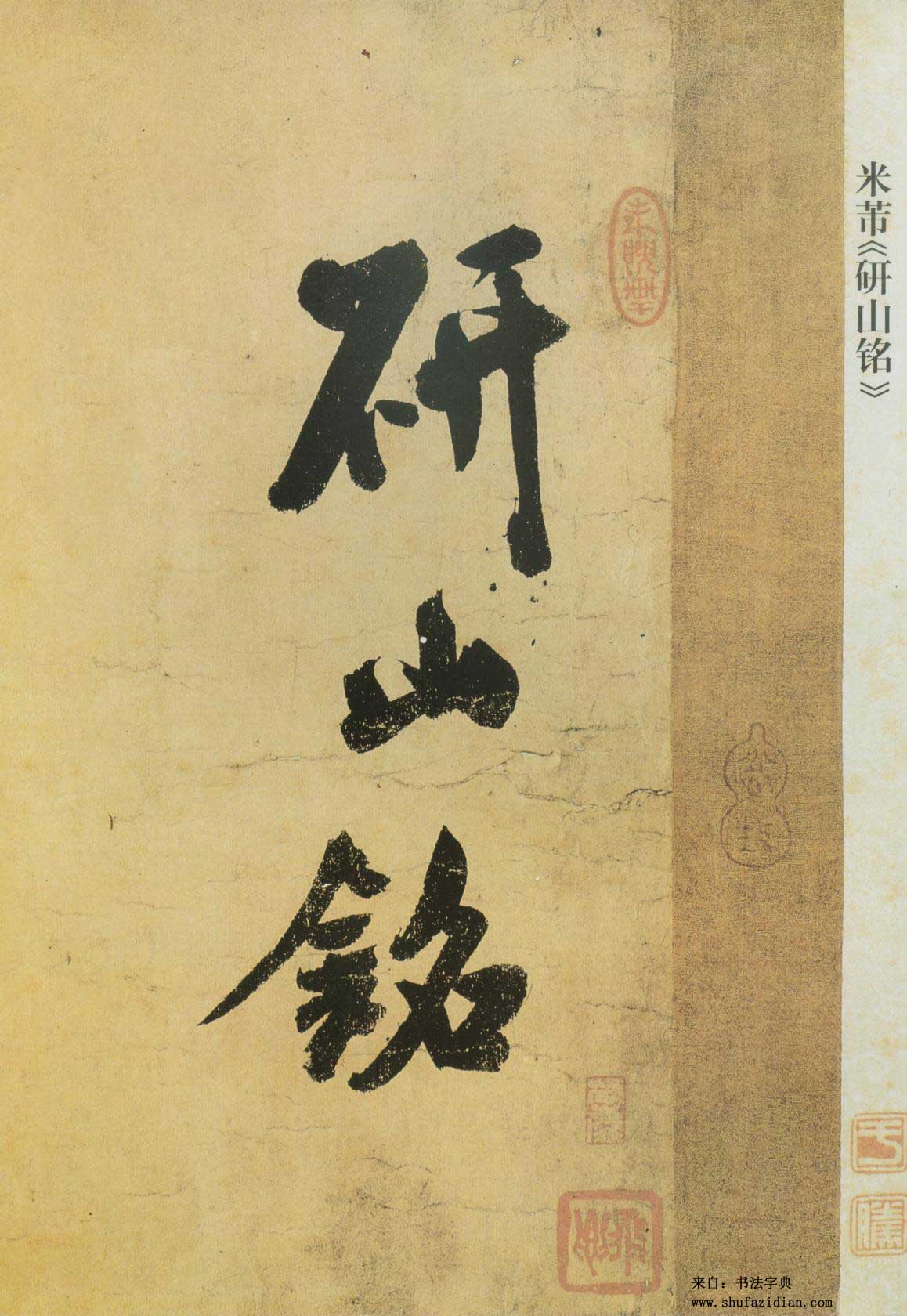
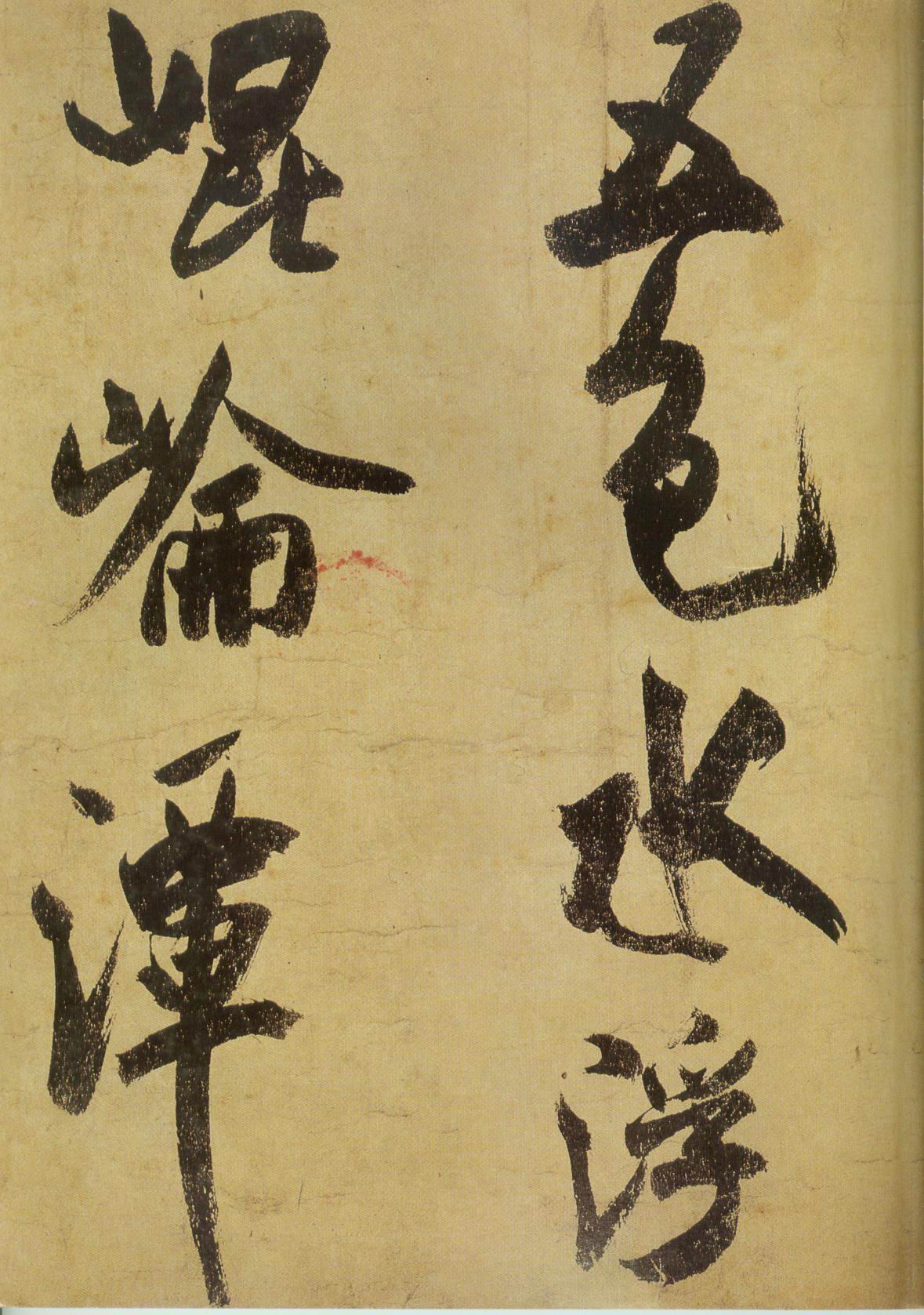
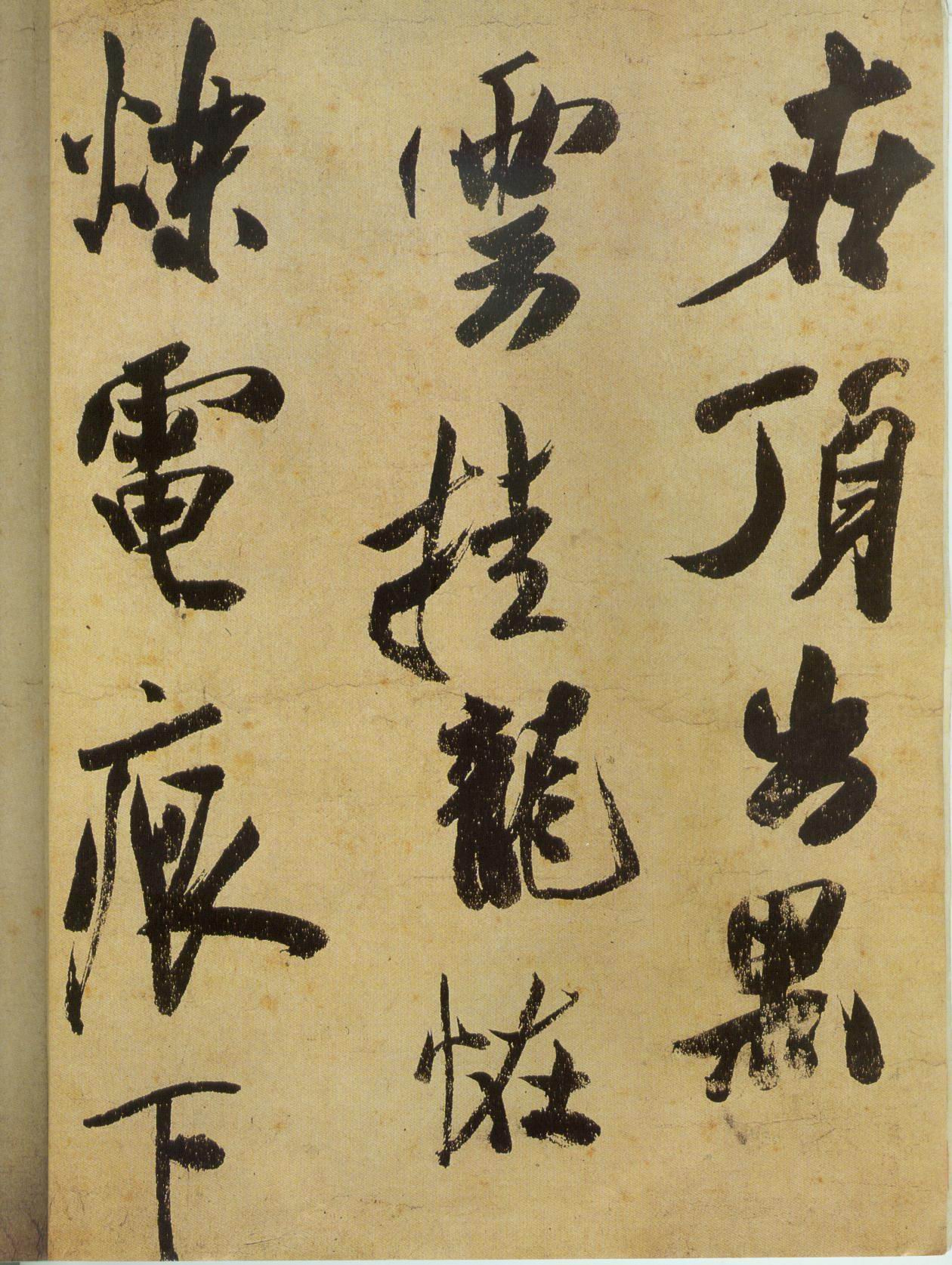
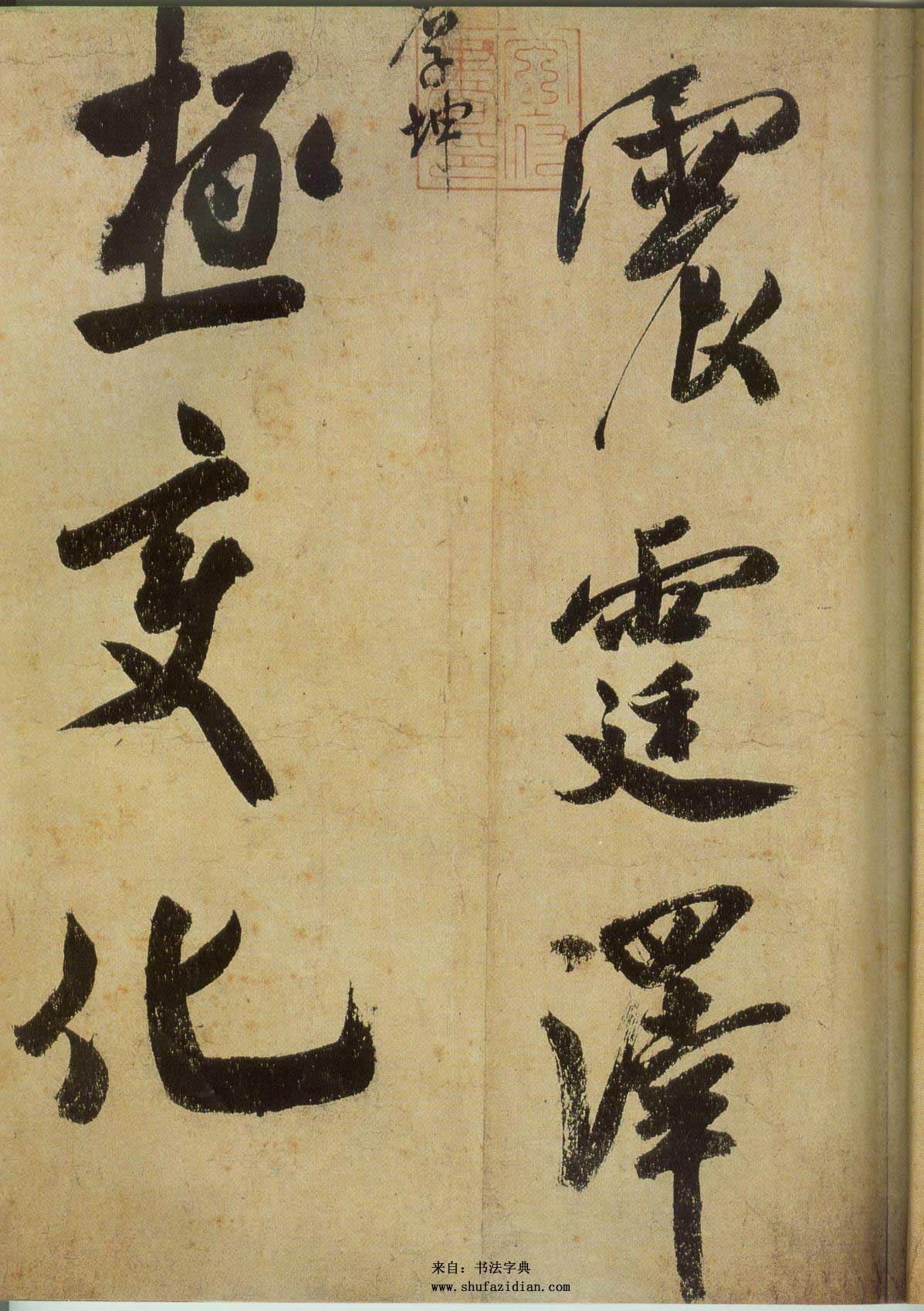
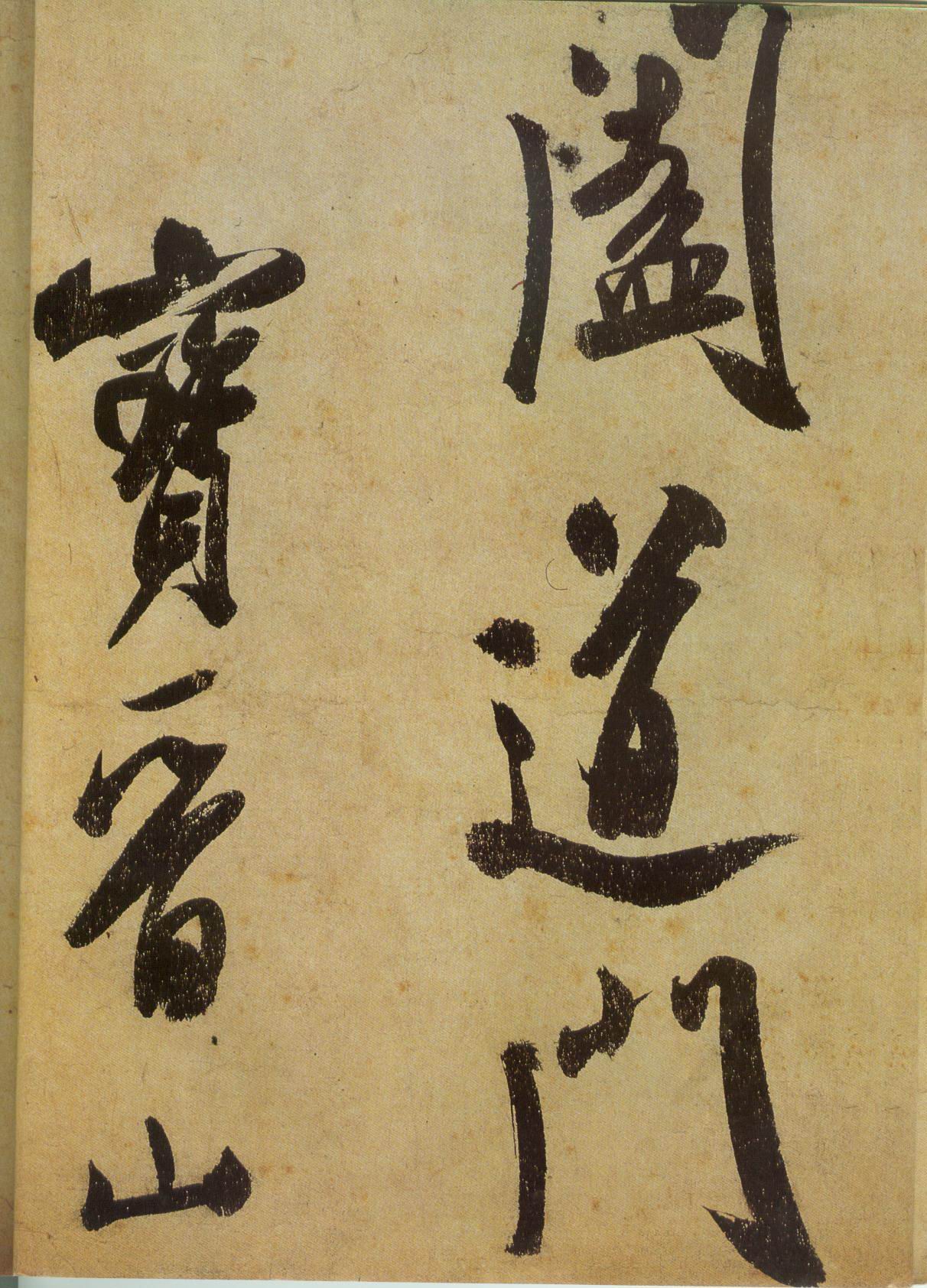
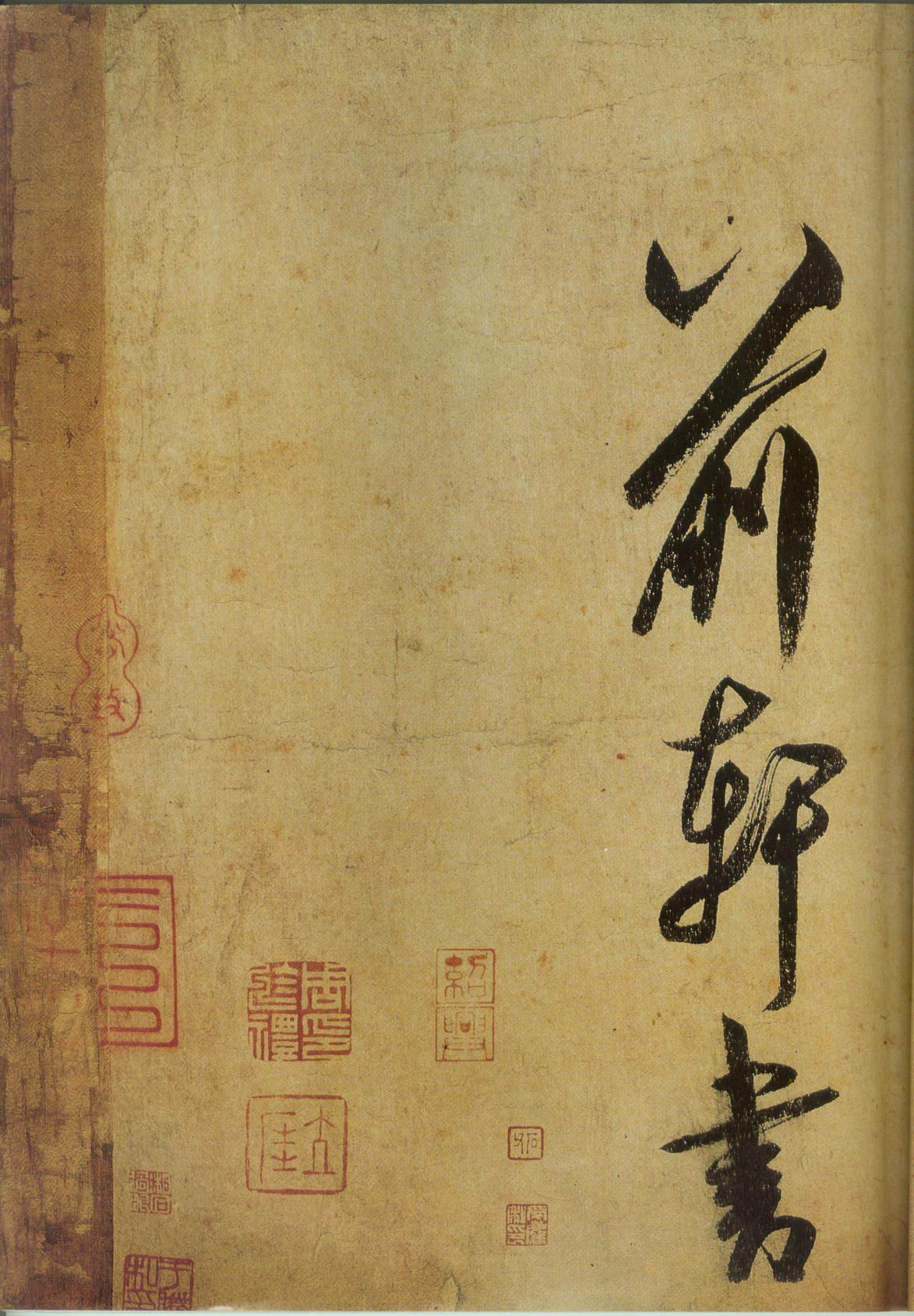

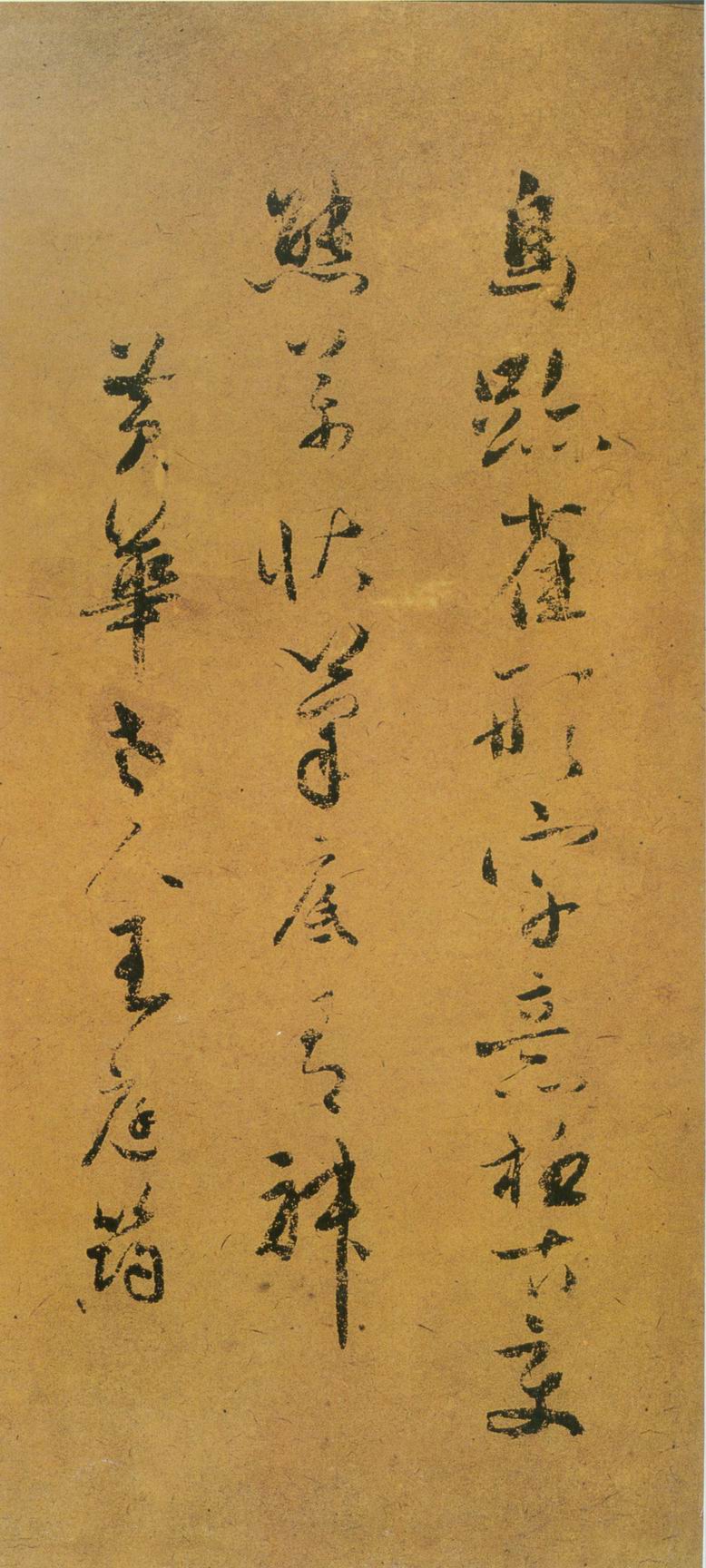
In March 2002, Zhongmao Shengjia International Auction Co., Ltd. collected "Yanshan Inscription" from Japan. After learning about this situation, the State Administration of Cultural Heritage organized experts to identify and evaluate the "Yanshan Inscription" in accordance with the law. Experts unanimously believe that this piece is indeed an authentic work by Mi Fu, and suggest that the cultural relics department negotiate with the auction company and give priority to the state to purchase it. On December 6, 2002, the State Administration of Cultural Heritage purchased it at an auction for 29.99 million yuan, equivalent to 769,000 yuan per word. Its transaction price exceeded the 23.5 million yuan of the Northern Song Dynasty Huizong's "Sketch of Rare Birds" that was auctioned not long ago, setting a new world record for Chinese art auctions. After the auction result, "Yanshan Inscription" was handed over to the Palace Museum for collection. However, this is not why "Yanshan Ming", which has been well known in the calligraphy circles for thousands of years, is worth tens of millions.
It is precious because it is a masterpiece of the top master of Chinese calligraphy. Mi Fu, Su Shi, Huang Tingjian and Cai Xiang are known as the "Four Calligraphers of the Song Dynasty" and are the founders of calligraphy sects. Over the past five thousand years, there have been only a handful of such figures, including Wang Xizhi, Wang Xianzhi, Ouyang Xun, Yu Shinan, Chu Suiliang, Yan Zhenqing, Zhang Xu, Liu Gongquan, Huaisu, Mi Fu, Zhao Mengzhaoye and just a dozen others. Among them, Mi Fu's writing style "attacks from all sides" is extremely varied. It is the most difficult to write and the most expressive of personality, making him unique. Su Shi once sincerely praised Mi Fudang's "parallel development" with the calligraphy sage Wang Xizhi. Among the few works of Mi Fu that exist in the world, "Yanshan Inscription" is considered the most representative. It is said to be comparable to "the best running script in the world" and "The Preface to the Lanting Collection" and "the most difficult calligraphy in the world". .
Its treasure lies in its calligraphy art that shocks ancient and modern times. Shen Peng, president of the Chinese Calligraphers Association, told reporters that the characters in "Yanshan Inscription" are jade-like and difficult to write. He most admires the "Zhen" character in "Xia Zhenting": a stroke is suddenly as thin as silk and as stable as silk. The rock is the most dangerous way to reach the pinnacle. "Some people say it's a failure, but I think it's the best part. Just like a side ball in table tennis, or like a football bouncing on the door frame and then into the net, it's wonderful! It's like Confucius's discussion of the highest realm of life - 'following one's heart's desire' , and 'do not exceed the rules'."
It is rare because it is a "returnee from overseas" - a private museum in Japan that collected it sold it due to financial difficulties, and many of my masterpieces scattered overseas are stored in national museums in various countries. Such a good opportunity may never come again.
Therefore, the value of "Yanshan Inscription" must be extraordinary!
Mr. Qi Gong, chairman of the National Cultural Relics Appraisal Committee, once said, "I will never see Mi Fu's "Yanshan Inscription" in my life, and I will die with my eyes closed!" Mr. Qi Gong said as early as 1986 in his "Introduction to Calligraphy": " "Yanshan Inscription" is a representative work among Mi Fu's authentic works. Mi Fu's running calligraphy is the highest achievement. The writing of this post is free and horizontal, with many ups and downs. It is not restrained by predecessors and expresses his natural temperament. In his large calligraphy, It should be recommended as top grade.”
Regarding the authenticity of "Yanshan Inscription".
Before the directed auction, "Yanshan Inscription" was authenticated by many famous experts in the domestic cultural relics and calligraphy circles (including many top figures). The experts who participated in the appraisal unanimously believed that "Yanshan Inscription" was an authentic calligraphy by Mi Fu. , which has also been photocopied and published many times in the past. Although the original work does not have the name of the author, because there is an identification postscript by Mi Fu's son Mi Youren at the end of the post, it is believed that it was written by Mi Fu. Therefore, people have always regarded "Yanshan Inscription" as a handed down work of Mi Fu. No one has Pay attention to whether there are genuine or fake issues. However, just ten days after the directed auction of "Yanshan Inscription", "China Cultural Relics News" (published on January 1, 2003) published a "Letter from the Inscription", in which Fu Xinian, an expert who participated in the appraisal of "Yanshan Inscription", wrote: The correction said: "Wang Tingyun and Mi Youren's books are both imitations of later versions."
Not long after, the 3rd issue of "Chinese Calligraphy and Painting" in 2003 published the article "Distinguish the beauty after the dust is washed away--Distinguish the forgeries of Mi Fu (Yanshan Inscription)" by the famous painter Fan Zeng. In the article, Mr. Fan said that "Yanshan Inscription" "The second half of "It has always been a bad letter in the market, how could it come from Mi Fu's hand". Mr. Fan Zeng also pointed out that Mi Youren's postscript at the end of the "Yanshan Ming" volume should be based on Mi Fu's "Nine Cursive Scripts" written by Mi Youren's postscript. Others believe that there are overall organizational problems in "Yanshan Ming". When analyzing the quality and authenticity of a calligraphy work, the rules and regulations are crucial. The composition and structure of "Yanshan Ming" is very strange. Some lines are large and some are small. The energy between the words is not smooth, and the whole article is scattered. The typesetting is artificial and the columns are skewed. The sky is not aligned and the ground is not in order. It is quite different from Mi Fu's calligraphy in terms of coherent strokes and smooth flow of Qi. This disordered composition does not look like it was written naturally , but may be caused by a collection of characters. "Yanshan Inscription" is a later imitation calligraphy work with an unscripted writing style similar to that of Mi Fu. It is similar to some pseudo-inscriptions that appeared around Jiajing and Wanli in the Ming Dynasty. It was imitated during this period.
Finally, "Southern Weekend" (published on July 17, 2003) published an article by reporter Zhai Minglei "The Suspicion of the Forbidden City's Sudden Purchase of "National Treasures"", which pointed out: "Regarding the "Yanshan Inscription", the former deputy director of the Palace Museum Yang Xin has stood up to prove that, "Some time ago, the Friendly Edition "Yanshan Ming" was shrouded in the halo of the return of the national treasure and was hyped. Now that the dust has settled , it is time to think calmly. Don't make any mistakes. If you make another mistake, the world will see a joke and future generations will be deceived."
From common opinion to doubts, the issue of authenticity of "Yanshan Inscription" has become complicated. The issue of authenticity of "Yanshan Ming" needs further research.

